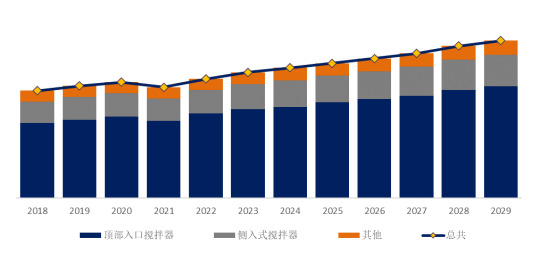#Industrial Agitators Market Share
Explore tagged Tumblr posts
Text
Data Bridge Market Research analyses the industrial agitators market will exhibit a CAGR of 6.20% for the forecast period of 2022-2029. Data Bridge Market Research report on coating additives market provides analysis and insights regarding the various factors expected to be prevalent throughout the forecast period while providing their impacts on the market’s growth. The rise in the demand for the various applications is escalating the growth of coating additives market.
#Industrial Agitators Market#Industrial Agitators Market Demand#Industrial Agitators Market Share#Industrial Agitators Market Forecast#Industrial Agitators Market Trend#Industrial Agitators Market Segment#Industrial Agitators Market Overview#Industrial Agitators Market Growth
0 notes
Text
#Vietnam Industrial Agitator Market#Market Size#Market Share#Market Trends#Market Analysis#Industry Survey#Market Demand#Top Major Key Player#Market Estimate#Market Segments#Industry Data
0 notes
Text
When I expressed my anxiety about how I need to get a job again, after frittering away my savings while doing higher-end hobbyistic writing that is public and vaguely pays (an extreme luxury to do this, I know), my dad's response was basically that I should just become a writer instead of going back to work. Of course I'm the biggest underachiever in my family and the only person who isn't published either through upper level academia or proper mass media, and all my life it feels like somebody has been saying to me "Why don't you just become awesome and famous" as if that's a career choice that has nothing to do with luck, charisma, and ability; as if I'm not sort of a mess with certain handicaps that no one else in the family shares. Unfortunately, this time my father had one piece of concrete advice that didn't just involve vaguely being special for a living, which is that my fancy brother is close friends with a successful editor at [redacted]. I do have at least one topic with potential mainstream appeal that I could pitch if someone tells me how the hell to do that, but the friend is, in my estimation, kind of a sociopath. One October he reached out to me about horror movies, and what I got out of that conversation is that he has no trouble digesting things like CANNIBAL HOLOCAUST full of real human abuse and animal torture, but he becomes angry if he sees anything with more challenging and inobvious intellectual content. The last time I saw him in person he was all agitated because he wanted to do a deal with Jordan Peterson, which a lot of his colleagues were scandalized by, and his only response was "It's gonna make money so what's the problem?" His interest in Jordan Peterson bothered me less than his weird, blank-faced ignorance of the fact that this might bother some people, his acting like that was a big surprise seemed to me to be really a bad sign. His wife is one of the more awful people I've met in person, one year she took up most of our Christmas dinner spewing some Sofia Coppola-type nonsense about the difficulties of being a beautiful poetess, before endlessly describing the sex practices of her polyamorous friends despite the many efforts of an elderly in-law to change the subject. Like anybody really needs to be thinking about all her buddies' played out dicks and pussies while we're trying to eat. Not that I would have to listen to her practice her needy, tacky self-marketing spiel if I worked with her shady husband, and it's not like I'm so naive that I think I can get around working with creeps in media industries, but it's harder to move forward when you know in advance how someone is specifically gross going in, it's not just an abstraction about the perils of business, it's That Guy. As usual my selective moral squeamishness is holding me back in life!
3 notes
·
View notes
Link
0 notes
Text
From the December 16, 2024 opinion piece:
Numerous writers, for example, Catherine Rampell, have condemned the assassination of United Healthcare CEO Brian Thompson, but also said it shows a way forward for the Democrats. People get agitated when they have a clear enemy. Democrats can rail against multimillionaire CEOs, painting them as enemies of the people, and massive corporations answerable only to their own stockholders. The blue team can run on punishing American oligarchs and giant multinational companies. For example, they can advocate levying much higher income taxes on rich people, a vastly higher estate tax so Elon Musk's kids don't become billionaires just because they had a rich father. They can push for a antitrust law that makes it illegal to have more than a 10% share of any market, in order to break up companies like United Healthcare and create more competition. Breaking up the big banks... and related laws for the insurance industry and other much-hated industries, could be a real winner.... It would be turning Sen. Bernie Sanders (I-VT) on his head. He argued that the government should do more to help people—for example, by raising the minimum wage. The new pitch would be about punishing the enemies of the people by taxing them or breaking them up, which would also help people (by raising revenue and allowing competition to lower prices) but the emphasis would be on punishing the villains. It works for the Republicans. They have plenty of villains in their stories and their voters love it. Democrats could do the same thing, only with different villains.
0 notes
Text
Industrial Agitators Market Size, Share, Opportunities and Growth Analysis, Top Key Companies To 2029
The global industrial agitators market is expected to be valued at USD 3.10 billion in 2024 and is projected to reach USD 3.99 billion by 2029; it is expected to grow at a CAGR of 5.2 % from 2024 to 2029 according to a new report by MarketsandMarkets™. Agitators are important in mixing, blending, and homogenizing ingredients during production processes. They also form an essential part in guaranteeing uniform distribution of active pharmaceutical ingredients (APIs), chemical processes, oil & gas, mining, etc. Rise in the demand for homogeneous mixing, increased need for energy efficient mixing equipment or industrial mixer in pharmaceutical, chemical, and food & beverage industries, and growing adoption of customized industrial agitators are some of the major factors driving the industrial agitators market growth globally.
0 notes
Text
Roof Solar: Harnessing the Power of Rooftop Solar Energy for a Sustainable Future
Issues of climate change and energy shortages today place a premium on sustainable solutions within governments, businesses, and households. Roof solar energy systems are indeed one of the most impactful ways through which these challenges can be addressed. Not only do they provide an environmentally friendly source of energy, the long-term cost-saving opportunities that both commercial and residential users have at hand is indeed a remarkable advantage.
In this article, we’ll break down how rooftop solar energy works, its significant benefits, and why it should be part of the global movement toward a sustainable future. We’ll follow the PAS (Problem-Agitate-Solution) copywriting framework to build this narrative.

Problem: The rising energy prices and environmental degradation
There is now a great global energy crisis among the most pressing issues of our times. When the costs are increasing so much, more conventional energy such as coal, oil, and gas becomes very expensive and is also at the mercy of market price fluctuations. This makes electricity bills sky-rocket in businesses and homeowners. But the International Energy Agency says that energy prices in most of the world are now more than 30% higher than they were a decade ago and look set to rise yet higher still as fossil fuel reserves shrink.
In India, for example, electricity tariffs have become substantially high. From 2010 to 2020, the tariffs for electricity consumption by industries increase by around 8-10% annually. This has been enormously inconvenient for most industries, putting them into heavy competition to seek alternative sources of more reliable and cheaper forms of energy.
Environmental Impact
The over-reliance on fossil fuels also causes extreme harm to the environment. Carbon emissions from energy sources have proven to contribute to global warming, inconsistent weather patterns, melting ice caps in polar regions, and increased sea levels. The United Nations reports that carbon dioxide emitted into the atmosphere due to energy use covers 75% of the planet's greenhouse gas emissions.
According to the World Health Organization, 9 in every 10 people around the world breath polluted air, while the WHO standards are exceeded. Fossil fuel-based electricity-generating power plants are amongst the largest contributors to global pollution. Emissions from fossil fuel extraction, processing, and burning greatly affect air quality in cities that hold heavy industrial activities and, directly affect public health through respiratory and other long-term health conditions. These are tough, physical problems with which business people and individuals have to deal each day. More expensive energy and irreversible damage to our planet require immediate answers. The question is: how can a shift toward an affordable, sustainable, and clean energy system be supported?
Agitate: Compound Effects of Ignoring the Problem
Monetary Cost for Households and Enterprises. Ignoring this kind of rising cost of energy impacts not only the electricity bill but the overall financial condition of the household and business. In the case of households, more expensive rates for energy translate directly into less disposable income for other kinds of necessity. This is even a bigger issue in developing countries, where the incomes are relatively small but the needs for energy are tremendous.
Businesses are highly vulnerable to energy price variations. A case study developed by the Federation of Indian Chambers of Commerce & Industry in 2019 reports that electricity price increases have led to a fall of up to 15-20% in profit levels for most Indian manufacturing firms. That leaves little scope to spend upon such initiatives since energy takes the lion's share of the companies' budget.
Environmental Effects From a purely environmental perspective, it is disastrous to maintain the scenario of dependence on fossil fuel. The Intergovernmental Panel on Climate Change warned that if carbon emissions continue at their current level, the Earth would witness a temperature rise of over 1.5 degrees Celsius by 2030. That could raise the chance of more frequent instances of natural calamities-from droughts to floods-with agriculture and housing under threat and human survival overall under question.
Energy-intensive companies are also under regulatory pressure due to strict environmental law by governments. Wherever targets for carbon emissions reduction are not met, they face fines or penalties, or even reputational risks if the same becomes known to the regulators, and that too in geographies where consumer awareness of climate change is rising.
If the trend continues uninterrupted, businesses and households will soon be placed in positions ever-more clearly perilously strained financially and contributing to the ongoing destruction of the planet.
The Rise of Roof Solar: A Sustainable Alternative
So, how do we combat the dual challenge of rising energy costs and environmental degradation? The answer lies in solar energy, particularly roof solar solutions. Roof solar systems allow homeowners and businesses to generate their own electricity using the power of the sun. By tapping into this abundant and renewable energy source, users can reduce their dependency on traditional power grids, lowering energy costs and minimizing environmental impact.
Rooftop solar energy has gained popularity in recent years, with countries like India, China, the United States, and Germany leading the adoption race. According to the Ministry of New and Renewable Energy (MNRE) in India, the country has set an ambitious target of installing 100 GW of solar power by 2022. Much of this growth will come from rooftop solar systems.
A case study conducted by the Indian Institute of Technology (IIT) Bombay demonstrated that installing a 5 kW roof solar system on a typical residential building in Mumbai could offset nearly 60% of the household's electricity needs. Over a 25-year lifespan, this leads to savings of over INR 9 lakhs ($12,000) in electricity costs.
How Roof Solar Works
A roof solar system typically consists of solar panels, an inverter, and a storage system (like a battery). The panels are installed on the rooftop and capture sunlight, converting it into direct current (DC) electricity. The inverter then transforms this DC electricity into alternating current (AC), which can be used to power homes or businesses.
There are two main types of rooftop solar systems:
On-grid systems – These are connected to the public electricity grid, meaning that any excess electricity generated can be fed back into the grid, earning credits or payments through a process known as net metering.
Off-grid systems – These systems are not connected to the public grid and typically include battery storage to ensure that power is available even when the sun is not shining.
Financial Savings
One of the biggest advantages of installing a roof solar system is the long-term financial savings. While the initial installation cost can be substantial, solar energy systems typically pay for themselves within 5-7 years, depending on the system size and energy consumption.
In countries like India, the government offers subsidies and tax incentives for installing rooftop solar. The Pradhan Mantri Kisan Urja Suraksha Evam Utthaan Mahabhiyan (PM-KUSUM) scheme provides up to 30% of the benchmark installation cost as a subsidy for residential and commercial users. This dramatically reduces the upfront cost, making solar energy more accessible.
A recent case study by The Energy and Resources Institute (TERI) showcased a commercial business in Pune that installed a 100 kW rooftop solar system. Within 6 years, the business saved nearly INR 50 lakhs ($67,000) in electricity costs. Moreover, they reduced their carbon footprint by over 80 tons annually, highlighting how roof solar can provide both economic and environmental benefits.
Environmental Impact
Switching to roof solar energy has a profound impact on the environment. According to a report by the National Renewable Energy Laboratory (NREL), for every 1 kW of solar energy installed, approximately 1.4 tons of carbon dioxide are offset annually. This is equivalent to planting about 25 trees per year.
With India’s growing energy demand, adopting roof solar systems across urban and rural areas could lead to a significant reduction in the country's overall carbon emissions. A 2020 study by Greenpeace India revealed that if just 10% of Indian households installed rooftop solar systems, it could offset over 275 million tons of CO2 emissions annually.
Enhancing Grid Stability
In many parts of the world, especially in rural or remote areas, electricity supply can be unreliable, with frequent power cuts. Roof solar systems, especially when combined with energy storage solutions, can provide a stable and uninterrupted power supply. For businesses that rely on continuous operations, such as manufacturing units or IT firms, solar energy can help ensure productivity is not affected by grid failures.
One of the key advantages of roof solar systems is that they can reduce the overall load on national power grids. As more households and businesses generate their own electricity, demand on the public grid decreases. This allows for more stable energy distribution and helps avoid blackouts during periods of high demand.
Future of Roof Solar Energy
Rooftop solar systems are a vital component of the world's transition to sustainable energy. Put simply, they offer concrete answers to the ills of soaring energy prices, environmental degradation, and unpredictable power grids. households and businesses can get reliable energy supply at lower costs and create a healthier planet by tapping into the power of the sun.
Data-driven case studies show that solar power is not an ideal for tomorrow but a present solution. Government subsidies as well as increasing demand for clean energy are going to make roof solar be at the center in building a clean future.
Whether you’re looking to save on your energy bills
What are some common misconceptions about rooftop solar?
Several misconceptions surround rooftop solar energy that make it unattractive for consideration by people. Here is the clarifying of the most common ones:
Rooftop Solar is Too Costly Myth: Most people believe it is too expensive to install rooftop solar panels. Reality: The installation cost is indeed high upfront, but the long-term savings on electricity bills do normally outweigh the costs incurred. In addition, a host of incentives, tax credits, and financing options also make solar possible and affordable. For example, in the United States, there is a federal solar tax credit where homeowners can deduct a part of installation costs from their taxes.
2. Solar Panels Does Not Work In Cloudy Weather And Cold Countries
Myth: Solar panels don't work well in areas with less sunlight or higher temperatures. Reality: Solar panels still generate electricity on cloudy days and in cold climates. As the sun's radiation is based on light rather than heat, solar panels can function. Further, it is indeed proved that such panels are more efficient in cool temperatures. Too much heat can decrease efficiency.
3. Rooftop Solar Requires a Lot of Maintenance
Myth: Solar panels require constant maintenance and cleaning. Reality: Modern solar panels are low maintenance. They are supplied with no moving parts and withstand all kinds of weather. They may require a few good cleanings and an occasional inspection to keep them operating at peak levels.
4. Solar Panels Will Damage My Roof
Myths: It will damage the roofing structure when installing solar panels. Reality: Solar panels can protect and preserve the roof when installed by professionals. They protect the roof from elements, which may increase the lifespan of the roof. Additionally, most of these installations come with warranties that will cover any damage incurred.
Rooftop Solar is Only for Homeowners Misconception: Rooftop solar can only be used by a house owner. Reality: Even tenants or residents of an apartment complex can benefit from solar power through community solar programs. Many people sharing the benefits of one single installation can make solar accessible to people.
6. Solar Energy Storage is Inefficient and Expensive
Myth: Storage of solar energy to use during cloudy days is not feasible. Reality: Researches into battery technology have helped make energy storage more efficient and cheaper. There are batteries, such as the Tesla Powerwall, where unused daylight may be stored for later use during the night or under clouded skies.
Rooftop Solar is an Aesthetically Unpleasant Investment Misconception: Solar panels will make my house look ugly.
Reality: Latest thin-film solar panels come in smooth designs that can be incorporated with the roof. More importantly, building-integrated photovoltaics offer options for integrating solar cells into building materials without removing the aesthetic value of the property.
Solar Panels Have a Short Lifespan
Wrong belief: Solar panels should be replaced more often.
Reality: Most photovoltaic solar panels come with warranties that last for 20 to 25 years, but typically will last longer, if maintained. Their efficiency will decrease incrementally, but they will continue producing electricity for many years.
9. Rooftop Solar is Not Very Efficient Debunking :
Solar panels do not generate enough energy to be useful. Reality is that solar technology has advanced, and modern panels are highly efficient. Depending on the system size and location, rooftop solar can generate a significant portion of a household's energy, sometimes producing excess energy that can be sold back to the grid.
10. Sun Energy Is Not Reliable : The sun is too intermittent an energy source to be dependable for power.
Despite the fluctuation that comes with production in solar energy, combining it with energy storage solutions and integrated incorporation into the grid only promises power. Reliability and stability of solar systems have been proven in many regions where this application is highly embraced. By addressing these misconceptions, we can better understand the true potential and benefits of rooftop solar energy. It's a powerful step towards a sustainable and energy-independent future. If you have any more questions or need further clarification, feel free to ask!
0 notes
Text
Bioreactors Market - Forecast(2024 - 2030)
Bioreactors Market Overview
Bioreactors Market size is estimated to reach 2.1Bn, growing at a CAGR of 6.91% during the forecast period 2020-2025. Bioreactors are devices used to develop biological processes by closely monitoring controlled environment. It is a closed system used for bioprocessing, that supports the growth of cells or tissues and organisms (yeast, bacteria, or animal cells) under controlled conditions. Bioreactors are used in industrial processes to produce vaccines, antibodies and others. It converts raw materials into useful byproducts in the bioconversion of corn into ethanol. These are commonly cylindrical, ranging in size from liters to cubic meters, and are often made of stainless steel. Single-use material is widely used in the field of mammalian cell culture and is now rapidly replacing conventional bioreactors owing towards increase the quality of the end product by reducing automation complexity.
Report Coverage
The report: “Bioreactors Market – Forecast (2020-2025)”, by IndustryARC covers an in-depth analysis of the following segments of the Bioreactors Market.
By Type: Continuous Stirred Tank Bioreactors, Bubble Column Bioreactors, Airlift Bioreactors, Fluidized Bed Bioreactors, Packed Bed Bioreactors and Photo-Bioreactors.
By Control Type: Manual Control and Automated Control.
By Application: Lab-Scale Production, Pilot-Scale Production and Full-Scale Production.
By Material: Glass, Stainless Steel and Single-Use Plastic Polymer.
By End User: Research & Development, Biopharmaceutics and Others.
By Geography: North America, Europe, Asia-Pacific and Rest of the World.
Request Sample
Key Takeaways
The increase in the number of personalized medicines coupled with rising number of FDA approved orphan drugs has increased bio production, accelerating the bioreactors demand over the forecast years.
Rising chronic diseases and favorable government initiatives to improve healthcare infrastructure is likely to be the major driving factor for the market’s growth.
Asia-Pacific region is projected to record the fastest growth rate during the forecast period 2020-2025
By Type - Segment Analysis
In 2019, Continuous Stirred Tank Bioreactors segment dominated the Bioreactors Market in terms of revenue is estimated to grow at a CAGR of 5.91% owing towards rising production of monoclonal antibodies (MAb) therapeutics and other biological using animal cell cultures. The continuous stirred-tank reactors are the equipped with an impeller for homogenizing culture media and a sparger for delivering oxygen to the cells. It has increased surface area for oxygen transfer, so there is an increased yield of products. These are mostly used in processing of industries, in homogeneous liquid-phase flow reactions, where constant agitation is required and which further is used in pharmaceutical industries abetting towards the growth of the market.
Inquiry Before Buying
Geography - Segment Analysis
In 2019, the North America region dominated Bioreactors Market in terms of revenue with a market share of 41.8% owing towards rising public & private funding for R&D in this region. In U.S., National Institute of Health (NIH) collaborated with 11 biopharmaceutical companies to launch the “Partnership for Accelerating Cancer Therapies (PACT)”, public-private research collaboration. The aim of the collaboration is to develop immunotherapy for cancers with total investment of $215m aids to the market’s growth. Government has taken initiatives to promote technological advancements and initiatives to escalate the drug development process are key factors in the growth of the Bioreactors market. Asia Pacific is set to record the fastest growth rate during the forecast period 2020-2025.
Schedule a Call
Drivers – Bioreactors Market
Rapid Growth Of Single Use Bioreactors In Biopharmaceutical Industries
The increasing adoption of single use bioreactors by biopharmaceutical companies and various research institutions is driving the growth of the market. Single use bioreactors are more feasible than traditional bioreactors for small-scale research and lab-scale applications as they are more economical and flexible. The use of SUBs for the production of biopharmaceutical companies are increasing, as it tends to be more cost-effective for small-scale operations are driving the markets growth.
Challenges – Bioreactors Market
Major Regulatory Concerns
Regulatory concerns regarding usage of bioreactors and growing stringent government policy and regulation toward market growth is restraining growth of the market. Lack of sufficient storage facilities, vulnerability to leaching and transportation is hindering the market’s growth. Also, large-scale disposal of plastic derivatives is a growing environmental concern restraining the business growth over the forecast years.
Buy Now
Bioreactors Industry Outlook
Product Launches was the key strategy of the players in the Bioreactors Industry. Bioreactors top 10 companies include Danaher Corporation, Sartorius AG, Eppendorf AG, ZETA Holding GmbH, Applikon Biotechnology B.V., Solaris Biotechnology srl, Pierre Guerin Technologies, Thermo Fisher Scientific Inc., Finesse Solutions, Inc. and Merck KGaA.
Acquisitions/Product Launches
In May 2019, Sartorius AG, a leading international partner of the biopharmaceutical industry launched ambr® 15 cell culture automated microbioreactor system. It offers increased flexibility and expanded capability for clone selection, media and feed optimization and early process development work.
In March 2020, Thermo Fisher Scientific Inc. to acquire QIAGEN, a leading provider of life science and molecular diagnostic solutions. This acquisition provided opportunity to leverage the industry-leading capabilities and R&D expertise to accelerate innovation and address emerging healthcare needs.
In March 2020, Danaher Corporation acquired Biopharma business from General Electric Company's (NYSE: GE) Life Sciences division. This acquisition helped company by driving its growth across multiple categories and in reaching more consumers.
#Bioreactors Market#Bioreactors Market Share#Bioreactors Market Size#Bioreactors Market Forecast#Bioreactors Market Report#Bioreactors Market Growth
0 notes
Text
Lord Rose Suggests Mohsin Issa, Asda Owner, Should Step Back

Asda chair Lord Stuart Rose has expressed that he feels “embarrassed” by the supermarket giant’s decline in market share and has urged co-owner Mohsin Issa to step back from the daily operations of the retailer.
“I’m going to be completely honest with you. Having been in this industry for a long time, I feel somewhat embarrassed. I won’t deny it,” Rose told The Telegraph in an interview. “I dislike being in second, third, or fourth place.
“And if you examine the current Kantar numbers or any other index, we’re not performing as well as we should. I find that unacceptable.”
Rose’s remarks follow Asda’s report of a 2.2% decline in quarterly sales and a 5.3% drop in like-for-like sales last week. The retailer’s market share has also decreased from 13.6% to 12.7%, losing ground to competitors such as Tesco, Sainsbury’s, Morrisons, and discount retailers, according to Kantar data.
Rose also suggested that Asda co-owner Mohsin Issa step back from day-to-day operations as the supermarket aims to improve its struggling performance.
“I would not advise him to get involved in operations, and I am the chairman,” he said.
We’ve always maintained that Mohsin was a certain horse for a specific course. He is an agitator, an entrepreneur, and a disruptor. It requires a different beast now that we’ve made many changes and added a sizable number of stores. To put it politely, Mohsin’s work is almost finished.
TDR Capital, a private equity group, owns 67.5% of Asda, while Mohsin Issa owns the remaining 22.5%. Mohsin’s brother Zuber Issa surrendered his 22.5% ownership in the company earlier this year in order to concentrate on his other ventures.
The American retail behemoth Walmart, which still owns 10% of Asda, formerly owned the grocery chain.
In 2021, the brothers paid £6.8 billion to TDR Capital to acquire Asda.
Asda’s chief financial officer, Michael Gleeson, unveiled the company’s ambitions to improve its store estate, increase staff hours to expedite shelf replenishment, and foster consumer loyalty last week.
Read More
0 notes
Text
0 notes
Text
Data Bridge Market Research analyses the industrial agitators market will exhibit a CAGR of 6.20% for the forecast period of 2022-2029. Data Bridge Market Research report on coating additives market provides analysis and insights regarding the various factors expected to be prevalent throughout the forecast period while providing their impacts on the market’s growth. The rise in the demand for the various applications is escalating the growth of coating additives market.
#Industrial Agitators Market#Industrial Agitators Market Demand#Industrial Agitators Market Share#Industrial Agitators Market Forecast#Industrial Agitators Market Trend#Industrial Agitators Market Segment#Industrial Agitators Market Overview#Industrial Agitators Market Growth
1 note
·
View note
Text
#Vietnam Industrial Agitator Market#Market Size#Market Share#Market Trends#Market Analysis#Industry Survey#Market Demand#Top Major Key Player#Market Estimate#Market Segments#Industry Data
0 notes
Text
0 notes
Text
Global Industrial Agitators Market is Poised for Significant Growth
The global industrial agitators market is poised for significant growth, expanding from USD 2.6 billion in 2023 to an estimated USD 3.2 billion by 2028, registering a CAGR of 4.2% during this period. This growth is driven by increasing demand across various industries, including chemicals, pharmaceuticals, food and beverage, and water and wastewater treatment.
Download PDF Brochure: https://www.marketsandmarkets.com/pdfdownloadNew.asp?id=59649096
Key Drivers of Market Growth
Chemical and Pharmaceutical Industries: The rapid expansion of the chemical and pharmaceutical sectors, particularly in the Asia-Pacific region, is a major driver. Companies are investing in specialized and differentiated chemicals, which requires advanced mixing and agitation technologies for production processes.
Food and Beverage Processing: The need for efficient and large-scale food processing solutions is also fueling demand for industrial agitators. These agitators play a crucial role in mixing ingredients and ensuring consistency and quality in food products.
Water and Wastewater Treatment: With increasing environmental regulations and the necessity for sustainable water management, the demand for industrial agitators in water and wastewater treatment applications is rising. These agitators help in maintaining proper fluid dynamics essential for effective treatment processes.
Key Market Segments
By Model Type: The market is segmented into large tank agitators, portable agitators, drum agitators, pail agitators, and tote agitators.
By Mounting: Top-mounted, side-mounted, and bottom-mounted agitators cater to different application needs.
By Component: Components such as heads, impellers, seals, propellers, turbines, and dispersers are critical in the functioning of industrial agitators.
By Form: Industrial agitators are used for solid-solid, liquid-gas, and other mixing forms.
Regional Insights
The Asia-Pacific region is expected to witness the highest growth rate, driven by the expanding chemical, pharmaceutical, and food processing industries in countries like China and Japan. North America and Europe also hold significant market shares due to established industrial sectors and technological advancements in these regions.
Leading Companies
Key players in the industrial agitators market include:
Ekato Group (Germany): Known for its wide range of agitators and complete process plants, catering to diverse applications from pharmaceuticals to biofuels.
NOV Inc. (US): Offers a variety of agitators and mixers under brands like Chemineer and Kenics, focusing on innovative fluid agitation solutions.
Sulzer Ltd. (Switzerland): Provides agitators and mixing solutions, particularly for the oil & gas, power generation, and paper & pulp sectors.
SPX Flow, Inc. (US) and Xylem Inc. (US): These companies are prominent in providing advanced mixing technologies and solutions globally.
0 notes
Text
Mastering PMVA Training Course: Your Path to Professional Excellence

Are you ready to take your career in healthcare or security to the next level? Picture this: You’re faced with a challenging situation that demands quick thinking and precise action. What if you could confidently navigate through such scenarios, ensuring the safety and well-being of yourself and those around you? Enter pmva training glasgow – your passport to mastering Prevention and Management of Violence and Aggression (PMVA).
Understanding PMVA: A Crucial Skill Set
In today's dynamic world, industries like healthcare, security, and social services often encounter situations where the risk of violence and aggression is prevalent. Whether you're a healthcare professional dealing with agitated patients or a security personnel facing potentially hostile individuals, having the right training is paramount. PMVA equips you with the necessary knowledge and skills to prevent, manage, and de-escalate such situations effectively.
What Does PMVA Training Entail?
Risk Assessment: Learn to assess potential risks and identify triggers that may lead to violent or aggressive behavior.
De-Escalation Techniques: Acquire techniques to defuse tense situations and calm agitated individuals through effective communication and non-verbal cues.
Physical Intervention: Gain practical skills in safe and appropriate physical intervention methods, ensuring minimal harm to all parties involved.
Legal and Ethical Considerations: Understand the legal and ethical frameworks surrounding the use of force and restraint, ensuring compliance with regulations and safeguarding human rights.
Why Choose PMVA Training?
1. Safety First, Always
Your safety and the safety of others is non-negotiable. PMVA equips you with the tools to prioritize safety in high-pressure environments, reducing the risk of injuries and promoting a culture of well-being.
2. Confidence in Crisis
Imagine having the confidence to handle challenging situations with ease. PMVA empowers you with the knowledge and skills to remain calm, composed, and in control, even amidst chaos.
3. Career Advancement Opportunities
In today's competitive job market, employers value candidates who possess specialized skills in risk management and conflict resolution. PMVA certification enhances your professional profile, opening doors to exciting career opportunities and advancement prospects.
4. Fulfilling Duty of Care
Whether you're a healthcare professional, security officer, or social worker, your duty of care extends to those under your supervision. By undergoing PMVA training, you demonstrate your commitment to providing the highest standard of care and safeguarding the well-being of vulnerable individuals.
The PMVA Training Experience
Embarking on a PMVA training course is more than just acquiring knowledge; it's a transformative journey towards personal and professional growth. Here's what you can expect from the experience:
Expert Guidance
You'll learn from seasoned professionals with extensive experience in risk management, conflict resolution, and behavioral psychology. Their practical insights and real-world scenarios will enrich your learning experience and prepare you for the challenges ahead.
Interactive Learning
Forget dull lectures and mundane presentations. PMVA training is interactive, engaging, and hands-on. Through role-playing exercises, case studies, and simulations, you'll develop practical skills that you can apply in real-life situations.
Supportive Environment
Learning can be daunting, especially when dealing with sensitive topics like violence and aggression. PMVA training creates a supportive and inclusive environment where you can ask questions, share experiences, and collaborate with fellow participants.
Ongoing Development
PMVA training doesn't end when the course concludes. It's a continuous journey of learning and improvement. You'll have access to resources, updates, and refresher courses to ensure that your skills remain sharp and up-to-date.
Conclusion: Empower Yourself with PMVA Training
In a world where uncertainty is the only constant, PMVA training provides a beacon of hope and assurance. By mastering the art of prevention and management of violence and aggression, you not only protect yourself and others but also become a catalyst for positive change in your workplace and community.
Are you ready to take the first step towards professional excellence? Enroll in a PMVA training course today and embark on a transformative journey that will shape your future for the better. Remember, the power to make a difference lies within you.
youtube
1 note
·
View note
Text
Portable Agitator, Global Market Size Forecast, Top 10 Players Rank and Market Share
Portable Agitator Market Summary
According to the new market research report "Global Portable Agitator Market Report 2023-2029", published by QYResearch, the global Portable Agitator market size is projected to grow from USD 947 million in 2023 to USD 1144 million by 2029, at a CAGR of 3.81% during the forecast period.
Figure. Global Portable Agitator Market Size (US$ Million), 2018-2029

Above data is based on report from QYResearch: Global Portable Agitator Market Report 2023-2029 (published in 2023). If you need the latest data, plaese contact QYResearch.
Figure. Global Portable Agitator Top 10 Players Ranking and Market Share (Ranking is based on the revenue of 2022, continually updated)

Above data is based on report from QYResearch: Global Portable Agitator Market Report 2023-2029 (published in 2023). If you need the latest data, plaese contact QYResearch.
According to QYResearch Top Players Research Center, the global key manufacturers of Portable Agitator include SPX Flow, EKATO, National Oilwell Varco, ALFA LAVAL, Dover, Satake, Admix, Zhejiang Great Wall Mixers, Milton Roy , Hayward Gordon, etc. In 2022, the global top 10 players had a share approximately 88.0% in terms of revenue.
Figure. Portable Agitator, Global Market Size, Split by Product Segment


Based on or includes research from QYResearch: Global Portable Agitator Market Report 2023-2029.
In terms of product type, Top Entry Agitator is the largest segment, hold a share of 71%.
Figure. Portable Agitator, Global Market Size, Split by Application Segment


Based on or includes research from QYResearch: Global Portable Agitator Market Report 2023-2029.
In terms of product application, Chemicals is the largest application, hold a share of 39%.
Figure. Portable Agitator, Global Market Size, Split by Region (Production)


Based on or includes research from QYResearch: Global Portable Agitator Market Report 2023-2029.
Figure. Portable Agitator, Global Market Size, Split by Region


Based on or includes research from QYResearch: Global Portable Agitator Market Report 2023-2029.
Market Drivers:
Demand from Various Industries: Industries such as chemical, pharmaceutical, food and beverage, and cosmetics rely heavily on portable agitators for mixing, blending, and agitation processes. The overall demand from these sectors, driven by factors like population growth, urbanization, and evolving consumer preferences, plays a significant role in market expansion.
Need for Flexibility and Mobility: Portable agitators offer the advantage of flexibility and mobility, allowing users to perform mixing tasks at different locations within a facility or even on-site. As industries increasingly prioritize agility and efficiency in their operations, the demand for portable solutions continues to rise.
Focus on Process Optimization: Efficiency and productivity are critical for industries aiming to remain competitive. Portable agitators contribute to process optimization by enabling faster mixing and blending, reducing downtime, and enhancing overall operational efficiency.
Technological Advancements: Advances in agitator design, materials, and control systems have led to the development of more efficient and versatile portable agitators. Features such as variable speed control, programmable operation, and enhanced durability appeal to end-users, driving market growth.
Opportunity:
Expansion into Emerging Economies: Emerging economies represent a significant opportunity for portable agitator manufacturers due to rapid industrialization, infrastructure development, and increasing investments in key sectors such as pharmaceuticals, chemicals, and food processing. Targeting these markets with tailored solutions and localized support can unlock substantial growth potential.
Customization and Specialization: Offering customizable portable agitators tailored to specific industry needs and applications presents a lucrative opportunity. By understanding the unique requirements of different sectors, manufacturers can develop specialized solutions that enhance performance, efficiency, and user experience, thereby capturing niche markets and commanding premium pricing.
Integration of Smart Technologies: The integration of smart technologies such as IoT (Internet of Things), AI (Artificial Intelligence), and automation presents an opportunity to differentiate portable agitators and offer added value to customers. Smart features such as remote monitoring, predictive maintenance, and real-time data analytics can optimize performance, minimize downtime, and improve overall operational efficiency.
About The Authors
Wupan-Lead Author
E-mail:[email protected]
About QYResearch
QYResearch founded in California, USA in 2007.It is a leading global market research and consulting company. With over 16 years’ experience and professional research team in various cities over the world QY Research focuses on management consulting, database and seminar services, IPO consulting, industry chain research and customized research to help our clients in providing non-linear revenue model and make them successful. We are globally recognized for our expansive portfolio of services, good corporate citizenship, and our strong commitment to sustainability. Up to now, we have cooperated with more than 60,000 clients across five continents. Let’s work closely with you and build a bold and better future.
QYResearch is a world-renowned large-scale consulting company. The industry covers various high-tech industry chain market segments, spanning the semiconductor industry chain (semiconductor equipment and parts, semiconductor materials, ICs, Foundry, packaging and testing, discrete devices, sensors, optoelectronic devices), photovoltaic industry chain (equipment, cells, modules, auxiliary material brackets, inverters, power station terminals), new energy automobile industry chain (batteries and materials, auto parts, batteries, motors, electronic control, automotive semiconductors, etc.), communication industry chain (communication system equipment, terminal equipment, electronic components, RF front-end, optical modules, 4G/5G/6G, broadband, IoT, digital economy, AI), advanced materials industry Chain (metal materials, polymer materials, ceramic materials, nano materials, etc.), machinery manufacturing industry chain (CNC machine tools, construction machinery, electrical machinery, 3C automation, industrial robots, lasers, industrial control, drones), food, beverages and pharmaceuticals, medical equipment, agriculture, etc.
0 notes